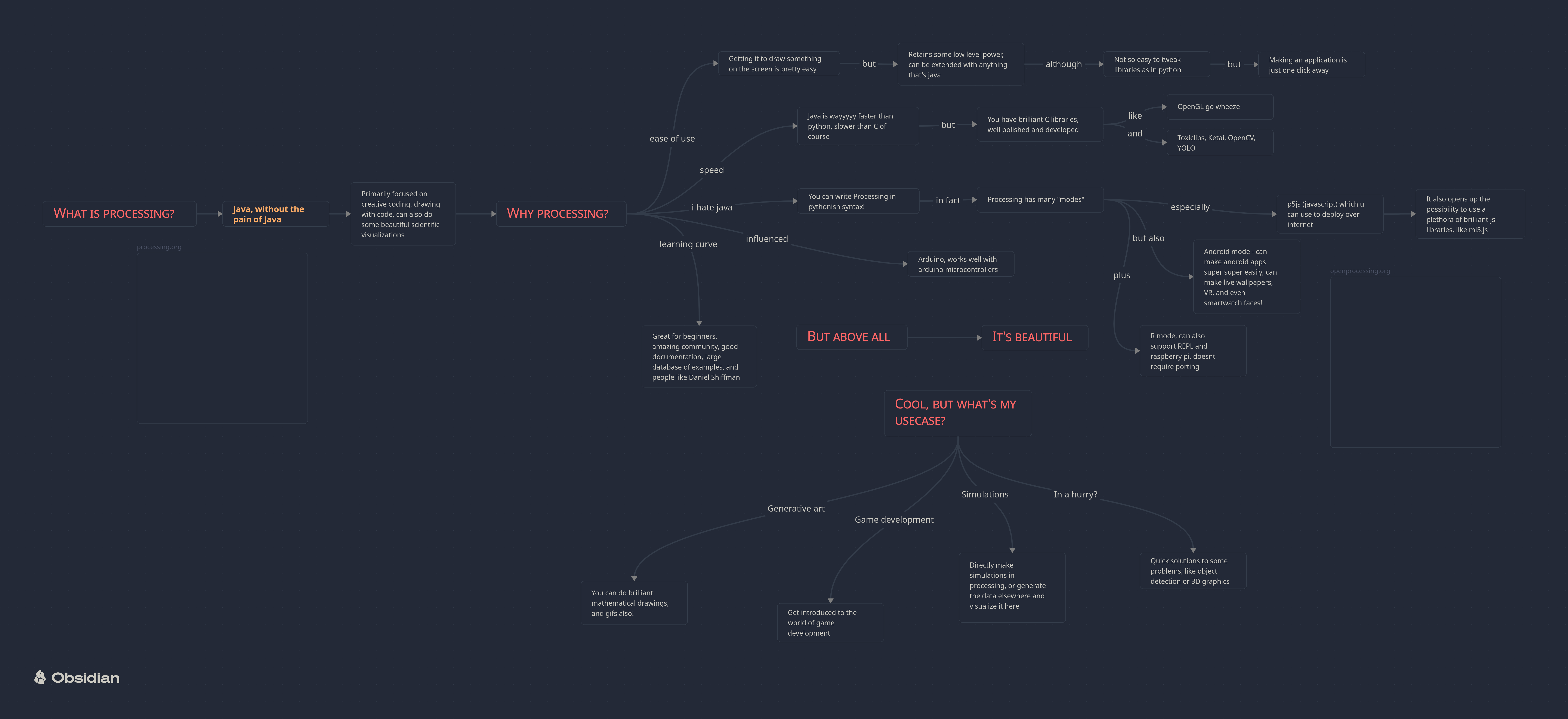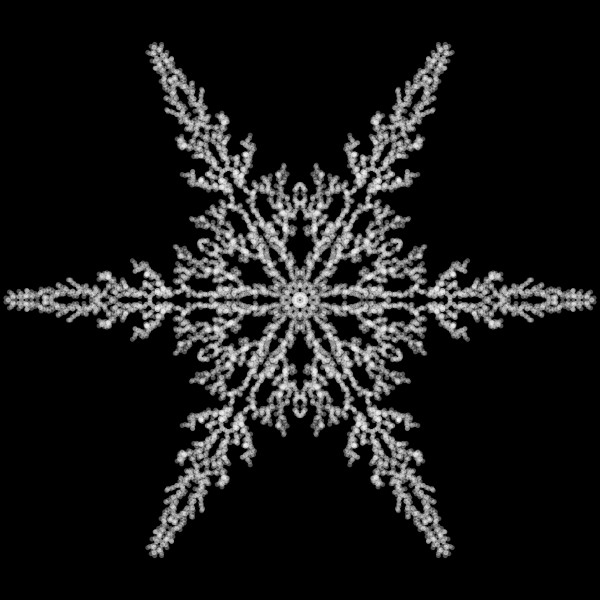- For downloading, examples and documentation visit the processing website
- Also check out websites of p5.js, android or the python mode of processing
- If you prefer to go through a book, The Nature of Code by Daniel Shiffman is an excellent one
- And of course, for YouTube videos, his channel The Coding Train can walk you through almost everything you can ask for
- Or just open up the Examples (Ctrl + Shift + O) from the Processsing IDE
- The OpenProcessing website (p5js!)
- Some others to get you hyped up -
- https://openprocessing.org/sketch/2124685
- https://openprocessing.org/sketch/1921375
- https://openprocessing.org/sketch/486307/
- https://openprocessing.org/crayon/29
- https://openprocessing.org/sketch/1240159
- https://openprocessing.org/sketch/1255271
- https://openprocessing.org/sketch/1593240
- https://openprocessing.org/sketch/505097
- https://openprocessing.org/sketch/1217113
- https://openprocessing.org/sketch/2060705
- https://www.patrik-huebner.com/creative-coding/ex8/
- https://physicsub-198fbf007acd.herokuapp.com/simulations (Akshay Shankar is one of the contributors here!)
- https://necessarydisorder.wordpress.com/2017/11/15/drawing-from-noise-and-then-making-animated-loopy-gifs-from-there/
- Daniel Shiffman's Video, on which our code was based on
- and this Code Golf StackExchange thread
- Diffusion Limited Aggregation
- Make a canvas, 600 pixels wide and 600 pixels tall, and draw a black background. Setup runs only once.
void setup() {
size(600, 600);
background(0);
}
- The code inside draw is kept running over and over again, each time the whole code inside draw is executed, the frame is updated.
void setup() {
size(600, 600);
background(0);
}
void draw() {
}
- A nucleation point is drawn at the center of the canvas - an circle with radius of 50 pixels -
ellipse(width/2, height/2, rad, rad); - And its colored translucent white -
fill(255, 80); - And we don't want to draw the edge of the ellipse -
noStroke();
float rad = 50;
void setup() {
size(600, 600);
background(0);
noStroke();
fill(255, 80);
ellipse(width/2, height/2, rad, rad);
}
void draw() {
}
- Variables x and y will store the coordinates our molecule -
float x, y; - In reality it's often a small droplet of supercooled water, and not a individual molecule
- We initialize the position of our water droplet at the center of the canvas -
x = width/2; y = height/2; - Make it move randomly in (kinda) Brownian motion -
x = x + random(-dizziness, dizziness); y = y + random(-dizziness, dizziness); - Draw the point -
point(x, y); - And color it aqua -
stroke(0, 150, 150);
float x, y;
float rad = 50;
float dizziness = 5;
void setup() {
size(600, 600);
background(0);
noStroke();
fill(255, 80);
ellipse(width/2, height/2, rad, rad);
x = width/2;
y = height/2;
}
void draw() {
x = x + random(-dizziness, dizziness);
y = y + random(-dizziness, dizziness);
stroke(0, 150, 150);
point(x, y);
}
- Start from the edge -
x = 0; y = height/2; - Push it forward -
x = x + random(-dizziness/4, dizziness);
float x, y;
float rad = 50;
float dizziness = 5;
void setup() {
size(600, 600);
background(0);
noStroke();
fill(255, 80);
ellipse(width/2, height/2, rad, rad);
x = 0;
y = height/2;
}
void draw() {
x = x + random(-dizziness/4, dizziness);
y = y + random(-dizziness, dizziness);
stroke(0, 150, 150);
point(x, y);
}
- if it escapes beyond half of the canvas -
if (x > width/2)
float x, y;
float rad = 50;
float dizziness = 5;
void setup() {
size(600, 600);
background(0);
noStroke();
fill(255, 80);
ellipse(width/2, height/2, rad, rad);
x = 0;
y = height/2;
}
void draw() {
x = x + random(-dizziness/4, dizziness);
y = y + random(-dizziness, dizziness);
stroke(0, 150, 150);
point(x, y);
if (x > width/2) {
x = 0;
y = height / 2;
}
}
- If the water molecule meets ice (i.e. white at (x, y)) -
if ( red(get(round(x), round(y))) != 0 ) - Then freeze -
ellipse(x, y, rad, rad);
float x, y;
float rad = 50;
float dizziness = 5;
void setup() {
size(600, 600);
background(0);
noStroke();
fill(255, 80);
ellipse(width/2, height/2, rad, rad);
x = 0;
y = height/2;
}
void draw() {
x = x + random(-dizziness/4, dizziness);
y = y + random(-dizziness, dizziness);
stroke(0, 150, 150);
point(x, y);
if (x > width/2) {
x = 0;
y = height / 2;
}
if ( red(get(round(x), round(y))) != 0 ) {
noStroke();
ellipse(x, y, rad, rad);
x = 0;
y = height / 2;
}
}
- Shift origin to the center of the canvas -
translate(width/2, height/2); - Coordinates in the new frame is now -
x = x - width/2; y = y - height/2; - Now rotate and draw 6 times -
ellipse(x, y, rad, rad); rotate(PI/3); - Reflect about x axis -
y = -y; - And draw 6 more
float x, y;
float rad = 50;
float dizziness = 5;
void setup() {
size(600, 600);
background(0);
noStroke();
fill(255, 80);
ellipse(width/2, height/2, rad, rad);
x = 0;
y = height/2;
}
void draw() {
x = x + random(-dizziness/4, dizziness);
y = y + random(-dizziness, dizziness);
stroke(0, 150, 150);
point(x, y);
if (x > width/2) {
x = 0;
y = height / 2;
}
if ( red(get(round(x), round(y))) != 0 ) {
noStroke();
translate(width/2, height/2);
x = x - width/2;
y = y - height/2;
ellipse(x, y, rad, rad);
rotate(PI/3);
ellipse(x, y, rad, rad);
rotate(PI/3);
ellipse(x, y, rad, rad);
rotate(PI/3);
ellipse(x, y, rad, rad);
rotate(PI/3);
ellipse(x, y, rad, rad);
rotate(PI/3);
ellipse(x, y, rad, rad);
rotate(PI/3);
y = -y;
ellipse(x, y, rad, rad);
rotate(PI/3);
ellipse(x, y, rad, rad);
rotate(PI/3);
ellipse(x, y, rad, rad);
rotate(PI/3);
ellipse(x, y, rad, rad);
rotate(PI/3);
ellipse(x, y, rad, rad);
rotate(PI/3);
ellipse(x, y, rad, rad);
rotate(PI/3);
x = 0;
y = height / 2;
}
}
forloops ftw yay -for(int i=0; i<6; i++)
float x, y;
float rad = 50;
float dizziness = 5;
void setup() {
size(600, 600);
background(0);
noStroke();
fill(255, 80);
ellipse(width/2, height/2, rad, rad);
x = 0;
y = height/2;
}
void draw() {
x = x + random(-dizziness/4, dizziness);
y = y + random(-dizziness, dizziness);
stroke(0, 150, 150);
point(x, y);
if (x > width/2) {
x = 0;
y = height / 2;
}
if ( red(get(round(x), round(y))) != 0 ) {
noStroke();
translate(width/2, height/2);
x = x - width/2;
y = y - height/2;
for(int i=0; i<6; i++) {
ellipse(x, y, rad, rad);
rotate(PI/3);
}
y = -y;
for(int i=0; i<6; i++) {
ellipse(x, y, rad, rad);
rotate(PI/3);
}
x = 0;
y = height / 2;
}
}
- Packing up everything into the -
void draw_snowflake()
float x, y;
float rad = 50;
float dizziness = 5;
void setup() {
size(600, 600);
background(0);
noStroke();
fill(255, 80);
ellipse(width/2, height/2, rad, rad);
x = 0;
y = height/2;
}
void draw() {
x = x + random(-dizziness/4, dizziness);
y = y + random(-dizziness, dizziness);
stroke(0, 150, 150);
point(x, y);
if (x > width/2) {
x = 0;
y = height / 2;
}
if ( red(get(round(x), round(y))) != 0 ) {
noStroke();
draw_snowflake();
x = 0;
y = height / 2;
}
}
void draw_snowflake() {
translate(width/2, height/2);
x = x - width/2;
y = y - height/2;
for(int i=0; i<6; i++) {
ellipse(x, y, rad, rad);
rotate(PI/3);
}
y = -y;
for(int i=0; i<6; i++) {
ellipse(x, y, rad, rad);
rotate(PI/3);
}
}
- Removing the speed limit of the maximum frame rate by not drawing a new frame until one molecule happens to stick -
while ( red(get(round(x), round(y))) == 0 ) - No more new drawing when snowflake edge hits canvas edge -
if (x < rad) noLoop();
float x, y;
float rad = 50;
float dizziness = 5;
void setup() {
size(600, 600);
background(0);
noStroke();
fill(255, 80);
ellipse(width/2, height/2, rad, rad);
}
void draw() {
x = 0;
y = height/2;
while ( red(get(round(x), round(y))) == 0 ) {
x = x + random(-dizziness/4, dizziness);
y = y + random(-dizziness, dizziness);
stroke(0, 150, 150);
point(x, y);
if (x > width/2) {
x = 0;
y = height / 2;
}
}
if (x < rad) noLoop();
noStroke();
draw_snowflake();
}
void draw_snowflake() {
translate(width/2, height/2);
x = x - width/2;
y = y - height/2;
for(int i=0; i<6; i++) {
ellipse(x, y, rad, rad);
rotate(PI/3);
}
y = -y;
for(int i=0; i<6; i++) {
ellipse(x, y, rad, rad);
rotate(PI/3);
}
}
- It still looks more like a snow blob rather than a snowflake.
- So let's make 'sticking radius' close to the 'mean free path' -
float rad = 5;
float x, y;
float rad = 5;
float dizziness = 5;
void setup() {
size(600, 600);
background(0);
noStroke();
fill(255, 80);
ellipse(width/2, height/2, rad, rad);
}
void draw() {
x = 0;
y = height/2;
while ( red(get(round(x), round(y))) == 0 ) {
x = x + random(-dizziness/4, dizziness);
y = y + random(-dizziness, dizziness);
stroke(0, 150, 150);
point(x, y);
if (x > width/2) {
x = 0;
y = height / 2;
}
}
if (x < rad) noLoop();
noStroke();
draw_snowflake();
}
void draw_snowflake() {
translate(width/2, height/2);
x = x - width/2;
y = y - height/2;
for(int i=0; i<6; i++) {
ellipse(x, y, rad, rad);
rotate(PI/3);
}
y = -y;
for(int i=0; i<6; i++) {
ellipse(x, y, rad, rad);
rotate(PI/3);
}
}
- We don't need the random walk trails anymore so we remove the line which was drawing the points
- And we save the image when our snowflake is finished -
saveFrame();
float x, y;
float rad = 5;
float dizziness = 5;
void setup() {
size(600, 600);
background(0);
noStroke();
fill(255, 80);
ellipse(width/2, height/2, rad, rad);
}
void draw() {
x = 0;
y = height/2;
while ( red(get(round(x), round(y))) == 0 ) {
x = x + random(-dizziness/4, dizziness);
y = y + random(-dizziness, dizziness);
if (x > width/2) {
x = 0;
y = height / 2;
}
}
if (x < rad) {
noLoop();
saveFrame();
}
noStroke();
draw_snowflake();
}
void draw_snowflake() {
translate(width/2, height/2);
x = x - width/2;
y = y - height/2;
for(int i=0; i<6; i++) {
ellipse(x, y, rad, rad);
rotate(PI/3);
}
y = -y;
for(int i=0; i<6; i++) {
ellipse(x, y, rad, rad);
rotate(PI/3);
}
}
-
Don't forget to play around and tweak your parameters! Feel free to drop me a mail if you have any questions or suggestions!
-
Happy snowflaking :D ❄

